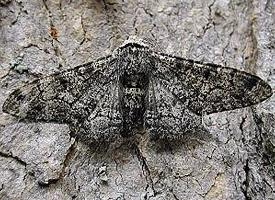
Állatleírás
The Peppered Moth (Biston betularia) is a fascinating species of moth that has become a textbook example of natural selection and evolutionary adaptation in action. Native to a wide range of habitats across the temperate regions of the world, including North America and Eurasia, this moth has played a significant role in the study of evolutionary biology.Physically, the Peppered Moth is a relatively small insect, with a wingspan ranging from 40 to 60 millimeters. The most striking feature of this moth is its highly variable wing coloration, which is primarily adapted for camouflage. The "typical" form of the moth has light-colored wings that are speckled with small dark spots, giving it a peppered appearance—hence the name. This coloration allows it to blend seamlessly into the lichen-covered trees and surfaces where it rests during the day, effectively hiding it from the sight of predators.
However, the Peppered Moth is perhaps best known for its "melanic" form, known as carbonaria, which has much darker, almost black wings. This form became prevalent during the Industrial Revolution in England when pollution from factories killed the lichens on trees and darkened the bark with soot. The darker moths, which were previously more visible to predators, became better camouflaged against the soot-covered trees than their lighter counterparts, leading to a dramatic increase in their numbers—a phenomenon known as industrial melanism.
The shift in the population from mostly light-colored moths to predominantly dark-colored moths in polluted areas, and back again to light-colored moths as pollution levels decreased and lichens recolonized the trees, is one of the most compelling pieces of evidence for natural selection. Scientists, starting with J.W. Tutt in the late 19th century and later Bernard Kettlewell in the 1950s, conducted groundbreaking studies on the Peppered Moth, demonstrating the role of predation in driving the change in the moth's coloration and providing a clear example of how species can adapt to changing environmental conditions.
The life cycle of the Peppered Moth begins with eggs that are laid on the leaves of trees and shrubs. The larvae, or caterpillars, are similarly camouflaged, with colors and patterns that blend into the foliage, protecting them from birds and other predators. After several weeks of feeding, the caterpillars pupate, emerging as adult moths ready to reproduce and continue the cycle.
In addition to its role in the study of natural selection, the Peppered Moth contributes to the biodiversity of its habitats. The caterpillars feed on a wide variety of deciduous trees and shrubs, including birch, willow, and oak, playing a part in the complex food web of their ecosystems.
The story of the Peppered Moth is a powerful reminder of the impact human activities can have on the natural world and the incredible capacity for adaptation that exists within species. It continues to be a subject of interest and study for scientists, educators, and nature enthusiasts alike, symbolizing the dynamic relationship between organisms and their environment.
Hasonló állatok
Új állatfotók
Top 10 állat
- Diana monkey (Cercopithecus diana)
- Dolphin gull (Leucophaeus scoresbii)
- Galápagos tortoise (Geochelone nigra complex)
- Moustached guenon (Cercopithecus cephus)
- Colossal squid (Mesonychoteuthis hamiltoni)
- Japanese spider crab (Macrocheira kaempferi)
- Stone loach (Barbatula barbatula)
- Common house mosquito (Culex pipiens)
- Common reed warbler (Acrocephalus scirpaceus)
- Sea urchins (Echinoidea)
